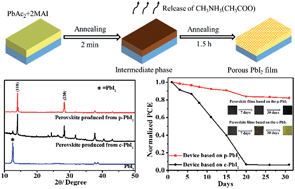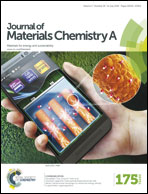Porous PbI2 films for the fabrication of efficient, stable perovskite solar cells via sequential deposition†
Abstract
Two-step sequential deposition has been widely used for the fabrication of organolead halide perovskites due to its efficient pore-filling in mesostructured perovskite solar cells (PSCs) and great controllability of the perovskite film morphology. However, due to the limited diffusivity of the organic salt, it is often difficult to fully convert a >150 nm compact PbI2 precursor film to perovskite during a sequential deposition process. Consequently, the uncontrollable amount of remnant PbI2 may not only affect the device reproducibility but also harm the air stability of the perovskite films. In this work, we developed a new method to synthesize PbI2 thin films with nano-pores and tunable crystal sizes. We found that the porous structure and small crystal size of the synthesized PbI2 can facilitate its conversion to CH3NH3PbI3 perovskite, resulting in a PbI2-free and highly oriented perovskite film. PSCs based on such perovskite films exhibit superior power conversion efficiencies as compared to the ones synthesized from compact PbI2 films; more importantly, the stability of the perovskite films and PSCs has been greatly improved.


 Please wait while we load your content...
Please wait while we load your content...